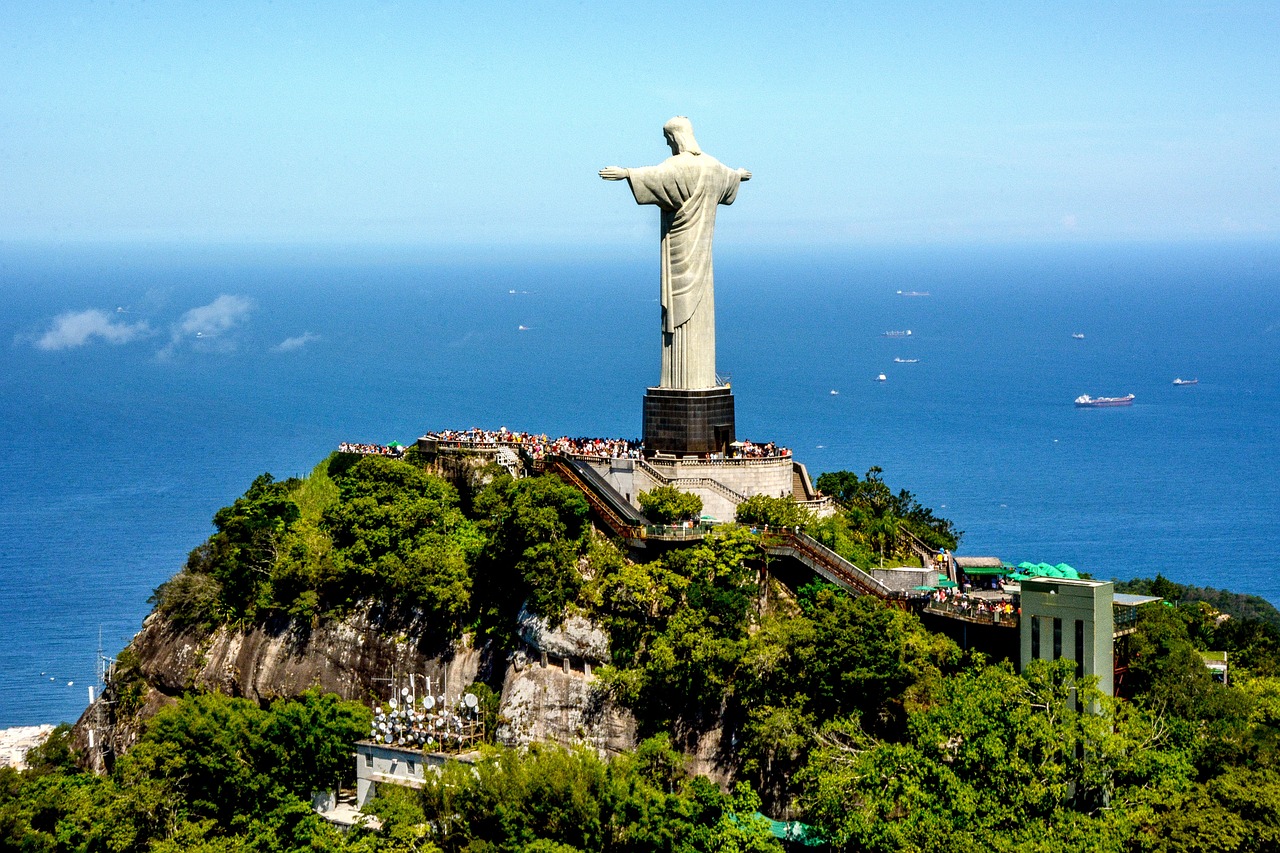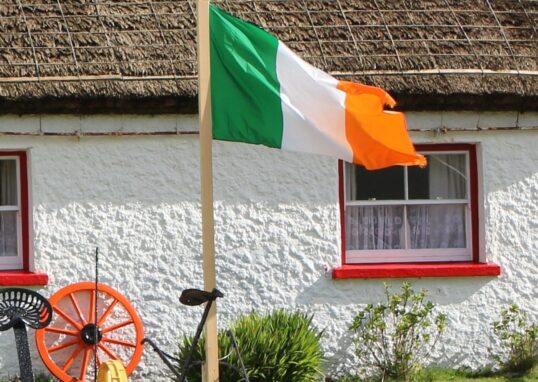
Guardian of Rio: How Christ’s Shadow Comforts World Below
Christ the Redeemer (Cristo Redentor) is an iconic landmark representing the city of Rio de Janeiro and Brazil. The magnificent statue of Jesus, the Redeemer, is located on the peak of Corcovado and is here to protect the town. This work of human intelligence and the product of the artist’s genius was completed in 1931 and stands as the face of Christianity and the evergreen Brazilian symbol of authenticity and natural beauty.
Christ the Redeemer, Brazil
Key Features and Attractions
The Statue Itself
Height and Dimensions
Christ the Redeemer’s height is exactly 30 meters, or 98 feet, to be more precise, and its 8-meter (26-foot) pedestal is not included in this measurement. It has a total height of 38 meters (125 feet) with an arm span of 28 meters (92 feet). The article is made of reinforced concrete and features thousands of triangular soapstone tiles in various colors.
Design and Construction
This statue was the idea of Hitor da Silva Costa. It was designed as a gift from the Brazilian Catholic community and sculpted by the French artist Paul Landowski. Construction took place, and an interruption occurred nine years later, with most funds coming from donations from the Brazilian Catholic community. The selection of components, such as chamoth, had to be sure and most resistant to the harsh conditions of Corcovado Mountain.
Corcovado Mountain
Location
Corcovado Mountain is situated in the Tijuca Forest National Park, one of the few tropical rainforests in the world located inside a metropolis, Rio de Janeiro. It is just a little over 2,329 feet or 710 meters in height. Furthermore, it offers a breathtaking view from the top of the city, as well as of the famous landmarks—Mount Sugarloaf, Copacabana Beach, and the Maracanã Stadium.
Access: Tourists riding the Corcovado Rack Railway can reach the statue in just 20 minutes due to the scenic Tijuca Forest. They can also get it by road, although doing so requires navigating through a couple of hairpin turns. Urban trails can also be utilized if one prefers an individual trek to the summit.
Panoramic Views
Viewing Platforms
The bottom of the statue features large platforms that provide the viewer with a fantastic experience of watching Rio de Janeiro. It is time for them, but visitors will be the ones who can see as far as Niterói on the other side of the Bay of Guanabara, or the cityscape of Rio. It seems that the place is at its peak in terms of visitor attraction during early morning and late evening, as the view is best at these times.
Photography
Christ the Redeemer belongs to those landmarks that are the most shots everywhere in the world. Just below it, tourists can take some of the most amazing shots with Rio de Janeiro as a backdrop. Equally, the nighttime views are unmatched in their beauty.
Cultural and Religious Significance
Symbol of Christianity
The statue’s outstretched arms are a gesture of embrace, welcoming all who come to Rio de Janeiro.
World Heritage Site
In 2012, the statue was named one of the New Seven Wonders of the World and is part of the UNESCO World Heritage site that includes Rio de Janeiro’s Carioca Landscapes.
Restoration and Preservation
Maintenance
Due to its exposure to the elements, the statue is preserved through regular maintenance and restoration work, which includes cleaning, repair, and the application of weather-resistant coatings.
Recent Restorations
The most significant restoration occurred in 2010, involving a comprehensive cleaning, the repair of cracks, and the replacement of missing tiles. During the 2014 FIFA World Cup, the statue was illuminated in the colors of the Brazilian flag to symbolize national pride.
Best Time to Visit
Weather Considerations
Christ the Redeemer is the best place to visit during the dry season, which runs from May to September, when the weather is cooler and the skies are clear, allowing for a stunning view of the city’s beauty at 700 meters elevation on Corcovado Mountain and its surrounding areas.
Time of Day
The best times to visit are early morning or late afternoon, when you can avoid crowds and enjoy the best lighting for photography.
Accessibility and Amenities
Visitor Facilities
The vicinity offers various facilities, including a gift shop, a cafeteria, and restrooms. The pathway to the statue is wheelchair-friendly and features elevators and escalators, making it easy for guests to access the upper platforms.
Guided Tours
Christ the Redeemer is one of the must-see attractions in Brazil, and most tourists usually visit it in conjunction with other famous tourist spots in Rio de Janeiro as part of guided tours, which provide the history and meaning of the statue for the host city.
Standing tall at Rio de Janeiro, Brazil, one of the world’s most iconic landmarks, Christ the Redeemer is majestic. Hovers. It is a state of peace, unity, and faith for the world. On top of Corcovado, 700 meters above sea level, this monument is a work of art that offers panoramic beauty, not confined to the religious vortex of devotion, but also to the magical beaches and the lush Tijuca National Park. The idol is 30 meters tall, with an extra 8-meter pedestal, and a 28-meter-wide arm spire.
Nevertheless, Christ the Redeemer is a remarkable construction and a perpetual spiritual sanctuary for locals and tourists alike. The figure was completed in 1931 after half a decade of hard-bought construction, designed by Brazilian engineer Heitor da Silva Costa and sculpted by French artist Paul Landowski. Unlike its seaside neighbor, the town features skyscrapers on one side and the lush green of the mountains on the other, immersed in a permanent festive atmosphere where Ipanema and Copacabana blend. It is made of reinforced concrete and is covered with thousands of triangular soapstone tiles, which, however, glitter in the sun and are visible from almost every corner of Rio. This proves how hospitable Rio is and how much it shares the spirit of Brazil.
Guiding the train through the dense Tijuca Forest, guests will see the summit of the forest, the world’s third-largest urban rainforest. However, there are also hiking trails that are more exciting for the visitor. The summit of the Redeemer of Christ is where everybody arrives. A fantastic scene takes them to the top of the world, encompassing the familiar spots around Brazil, such as the Sugarloaf Mountain, Copacabana Beach, and the Maracanã Stadium. The most desirable times of the day are sunrise and sunset. During those hours, the sun paints the city with a magical touch; hence, it is one of the most-photographed spots in Brazil.
History of Christ the Redeemer
Christ the Redeemer’s open arms symbolize the Brazilian people’s hopeful, safe, and open-hearted spirit. Among other things, the image of the Christ the Redeemer statue is an important Christian symbol. Therefore, it holds both religious and secular meaning. Since it was one of the New Seven Wonders of the World in 2007, it has become the most visited place, attracting travelers from around the world.
Besides its religious and cultural significance, Christ the Redeemer is also a symbol of the unity of Brazil’s diverse inhabitants. The city of Rio de Janeiro, with its melting pot of cultures and people of multiple ethnicities, and the mix of different sights and traditions, is where the eponymous statue stands. The motto of Brazil, “Ordem e Progresso” (Order and Progress), has been a part of the country’s history for a long time. The famous statue of Christ the Redeemer is more than just a religious one. Even non-religious visitors to this statue may feel both peace and awe as they gaze at the gigantic statue beneath which the world’s most beautiful city, with all its splendor, unfolds.
The creation of Christ the Redeemer is a fascinating account of the international community’s cooperative effort and human ingenuity. Blais Paequeito, a poet from New York, was the one who first conceived the idea of building the statue in the 1850s. However, it wasn’t until twenty years later that the project finally began to catch fire. The people who provided most of the funding were the Catholic church in Brazil. The finished product seemed like a historical achievement that united the townspeople, a host of artisans and engineers, and an international committee of designers. Today, the statue symbolizes faith, resilience, and community, drawing a large number of tourists every year. Another travel destination, situated at the southern tips of Argentina and Chile, Patagonia captivates with stunning contrasts, awe-inspiring scenes, and pure adventure thrills. Few people live in this region, but it’s famous for its untouched wilderness.
Conclusion
The Christ the Redeemer has risen to embody the pride of Rio de Janeiro and the country of Brazil. Still, the fact of the matter is that it is not only a marvel of modern engineering and artistic achievement. The city’s monumental figure and the picture-perfect scenery mean that it should be seen by those who come to Rio. The enormous statue of Jesus Christ is found on the top of Corcovado Mountain, and from here, one can see the entire city. The statue was completed in 1931, and it is an excellent work of art and engineering, as well as a symbol of Christianity and a cultural icon of Brazil.









